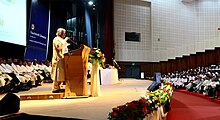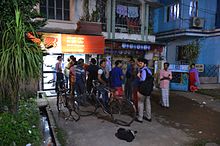Demonetisation always played an major role on the life of people as well as the status of the country.So now this time India is the country which have to undergo the changes and see the circumstances of the domestisation effect.The word domentisation is not familiar in India until the night of 9 november 2016 whwn the prime minister of india called upon a major conference and suddenly asked for the currency block on the 500rs and 1000rs notes.It produced a major rush between people that what to do with the old notes and how to pay fees and buy some major this for the lively beings.
The
demonetisation of
₹500 and
₹1,000 banknotes was a policy enacted by the
Government of India on 8 November 2016, ceasing the usage of all
₹500 (US$7.40) and
₹1,000 (US$15) banknotes of the
Mahatma Gandhi Series as
legal tender in India from 9 November 2016.
The announcement was made by the
Prime Minister of India Narendra Modi in an unscheduled live televised address at 20:15
Indian Standard Time (IST) on 8 November. In the announcement, Modi declared that use of all ₹500 and ₹1,000 banknotes of the
Mahatma Gandhi Series would be invalid after midnight of that day, and announced the issuance of new ₹500 and
₹2,000 banknotes of the
Mahatma Gandhi New Series in exchange for the old banknotes. However, the banknote denominations of ₹100, ₹50, ₹20, ₹10 and ₹5 of the
Mahatma Gandhi Series and ₹2 and ₹1 remained legal tender and were unaffected by the policy.
The government claimed that the demonetisation was an effort to stop
counterfeiting of the current banknotes allegedly used for funding
terrorism, as well as a crack down on
black money in the country. The move was also described as an effort to reduce
corruption, the use of drugs, and
smuggling.
However, in the days following the demonetisation, banks and ATMs across the country faced severe cash shortages. with severe detrimental effects on a number of small businesses,
agriculture,
and transportation. People seeking to exchange their notes had to stand
in lengthy queues, and several deaths were linked to the inconveniences
caused due to the rush to exchange cash. Also, following the announcement, the
BSE SENSEX and
NIFTY 50 stock indices crashed for the next two days.
Initially, the move received support from several bankers as well as
from some international commentators. It was heavily criticised by
members of the opposition parties, leading to debates in both houses of
parliament and triggering organised protests against the
government in several places across India. As the cash shortages grew in the weeks following the move, the demonetisation was heavily criticised by several economists.
EFFECTS OF DEMONTISATION:
Cash rush
Queue at an ATM for
₹100 banknotes in
Howrah, on 8 November 2016, 22:23 (IST)
People queue outside a private bank to deposit and exchange old
₹500 and
₹1000 banknotes in
Kolkata on 10 November 2016.
The scarcity of cash due to demonetisation led to chaos, and most
people holding old banknotes faced difficulties exchanging them due to
endless lines outside banks and ATMs across India, which became a daily
routine for millions of people waiting to deposit or exchange the
₹500 and
₹1000 banknotes since 9 November. ATMs were running out of cash after a few hours of being functional,
and around half the ATMs in the country were non-functional Sporadic violence was reported in
New Delhi, but there were no reports of any grievous injurypeople attacked bank premises and ATMs, and a ration shop was looted in
Madhya Pradesh after the shop owner refused to accept
₹500 banknotes
Several people were reported to have died from standing in queues for hours to exchange their old banknotes. Deaths were also attributed to lack of medical help due to refusal of old banknotes by hospitals. As of 15 November 2016, the attributed death toll was 25. In an interview,
Chief Minister of Delhi Arvind Kejriwal lashed out at a BBC reporter who asked him to justify his 19 November claim that 55 deaths were linked to demonetisation. While, the CMD of
Punjab National Bank said that panic after demonetisation started fading on 19 November 2016.As of 18 December 2016, there were still long queues at banks and ATMs.
Stock market crash
As a combined effect of demonetisation and
US presidential election,
the stock market indices dropped to an around six-month low in the week
following the announcement. The day after the demonetisation
announcement,
BSE SENSEX crashed nearly 1,689 points and
NIFTY 50 plunged by over 541 points. By the end of the intraday trading section on 15 November 2016, the
BSE SENSEX index was lower by 565 points and the
NIFTY 50 index was below 8100 intraday.
Transportation halts
After the demonetisation was announced, about 800,000 truck drivers
were affected with scarcity of cash, with around 400,000 trucks stranded
at major highways across India were reported. While major highway toll junctions on the Gujarat and Delhi-Mumbai
highways also saw long queues as toll plaza operators refused the old
banknotes.
Nitin Gadkari, the
Minister of Transport,
subsequently announced a suspension of toll collections on all national
highways across India until midnight of 11 November, later extended
until 14 November and again until midnight of 18 November, and yet again
till 2 December.
Agriculture
Transactions in the
Indian agriculture sector are heavily dependent on cash and were adversely affected by the demonetisation of ₹500 and ₹1,000 banknotes. Due to scarcity of the new banknotes, many farmers have unsufficient
cash to purchase seeds, fertilisers and pesticides needed for the
plantation of
rabi crops usually sown around mid-November. Farmers and their unions conducted protest rallies in
Gujarat,
Amritsar and
Muzaffarnagar against the demonetisation as well as against restrictions imposed by the
Reserve Bank of India on
district cooperative central banks which were ordered not to accept or exchange the demonetised banknotes.
Banking

A
State Bank of India branch remained open at night, and a long queue of people waited outside the ATM to withdraw money
In the first four days after the announcement of the step, about
₹3 trillion (US$45 billion) in the form of old ₹500 and ₹1,000 banknotes had been deposited in the banking system and about
₹500 billion
(US$7.4 billion) had been dispensed via withdrawals from bank accounts,
ATMs as well as exchanges over the bank counters. Within these four
days, the banking system has handled about 180 million transactions.The
State Bank of India reported to have received more than
₹300 billion (US$4.5 billion) in bank deposit in first two days after demonetisation. A spike in the usage of debit card and credit card post demonetisation was also reported.
Between November 10 and November 27, banks reported exchange and deposits of demonetised banknotes worth
₹8.45 trillion (US$130 billion) (exchange of
₹339.48 billion (US$5.0 billion) and deposits of
₹8.11 trillion (US$120 billion)). During this period, an amount of
₹2.16 lakh crore (US$32 billion) had been withdrawn by people from their accounts.
In
Malda, a district believed to be a transit-point for fake Indian currencies,a large sum of cash deposits in dormant accounts were also reported. According to
The Economic Times, more than 80 percent of fake currency in India originates from Malda district in
West Bengal.
Business
By the second week after demonetisation of
₹500 and
₹1,000 banknotes, cigarette sales across India witnessed a fall of 30–40%, while E-commerce companies saw up to a 30% decline in
cash on delivery (COD) orders. Several e-commerce companies hailed the demonetisation decision as an impetus to an increase in
digital payments. They believe that it would lead to a decline in COD returns which is expected to cut down their costs
The demand for point of sales (POS) or card swipe machines has increased. E-payment options like PayTM and PayUMoney has also seen a rise.According to data of Pine Labs, the demand for its POS machines doubled
after the decision. Further it states that the debit card transactions
rose by 108% and credit card transactions by 60% on 9 November 2016.
Income tax raids and cash seizures
The
Finance Ministry
instructed all revenue intelligence agencies to join the crackdown on
forex traders, hawala operators and jewellers besides tracking movement
of demonetised currency notes.
Income Tax departments raided various illegal tax-evasive businesses
in Delhi, Mumbai, Chandigarh, Ludhiana and other cities that traded with
demonetised currency. The
Enforcement Directorate issued several
FEMA notices to forex and gold traders.Large sum of cash in defunct notes were seized in different parts of the country.In
Chhattisgarh liquid cash worth of
₹4.4 million (US$65,000) was seized.














